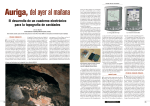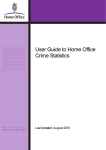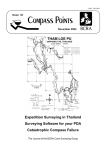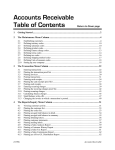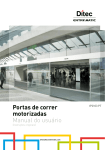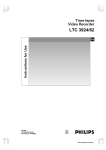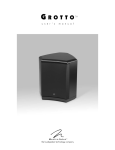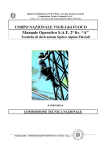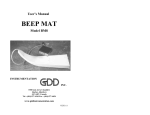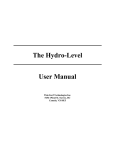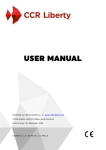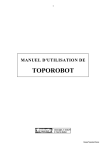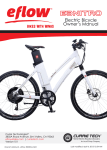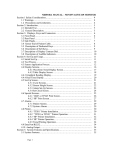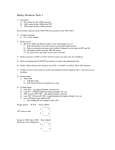Download Compass & Tape - National Speleological Society
Transcript
Compass & Tape, Volume 17 No. 1 Issue 57 Compass & Tape Volume 17 Number 1 Issue 57 Newsletter of the Survey and Cartography Section of the National Speleological Society 1 Compass & Tape, Volume 17 No. 1 Issue 57 Survey and Cartography Section The Survey and Cartography Section (SACS) is an internal organization of the NSS that is devoted to improving the state of cave documentation and survey, cave data archiving and management, and of all forms of cave cartography. Membership: Membership in the Section is open to anyone who is interested in surveying and documenting caves, management and archiving of cave data and in all forms of cave cartography. Membership in the National Speleological Society is not required. Dues: Does are $4.00 per year and includes four issue of Compass & Tape. Four issues of the section publication are scheduled to be published annually. However, if there are fewer, then all memberships will be extended to ensure that four issues are received. Dues can be paid in advance for up to 3 years ($12.00). Checks should be made payable to “SACS” and sent to the Treasuer. Compass & Tape: This is the Section’s quarterly publication and is mailed to all members. It is scheduled to be published on a quarterly basis, but if insufficient material is available for an issue, the quarterly schedule may not be met. Compass & Tape includes articles covering a wide range of topics, including equipment reviews, techniques, computer processing, mapping standards, artistic techniques, all forms of cave cartography and publications of interest and appropriate material reprinted from national and international publications. It is the primaly medium for conveying information and ideas within the U.S. cave mapping community. All members are strongly encouraged to contribute material and to comment on published material.. Items for publication should be submitted to the Editor. NSS Convention Session: SACS sponsors a Survey and Cartography session at each NSS Convention. Papers are presented on a variety of topics of interest to the cave mapper and cartographer. Everyone is welcome and encouraged to present a paper at the convention. Contact the Vice Chair for additional information about presenting a paper. Annual Section Meeting: The Section holds its only formal meeting each year at the NSS Convention. Section business, including election of officers, is done at the meeting. Back Issues: SACS started in 1983 and copies of back issues of Compass & Tape are available. The cost is $1.00 each for 1-2 back issues, $0.75 each for 3-6 back issues and $.50 each for more than six back issues at a time. Back issues can be ordered from the Treasurer. Overseas Members: SACS welcomes members from foreign countries. The rate for all foreign members is US$4.00 per year and SACS pays the cost of surface mailing of Compass & Tape. If you need air mail delivery, please inquire about rates. All checks MUST be payable in US$ and drawn on a U.S. bank. Chair: Vice Chair Carol Vesely 817 Wildrose Avenue Monrovia, CA 91016-3022 (818) 357-6927 Nigel Dyson Hudson 10 Slators Lane Newfield, NY 14867 (607) 564-7927 [email protected] Secretary: Robin Barber 4312 Winding Way Fort Worth, TX 76126 [email protected] Treasurer: Bob Hoke 6304 Kaybro Street Laurel, MD 20707 (301) 725-5877 [email protected] Editor: Patricia Kambesis Hoffman Environmental Research Institue Western Kentucky University Bowling Green, KY 42721 ph: 270-745-5201 [email protected] 2 Compass & Tape, Volume 17 No. 1 Issue 57 INSIDE Call for Papers, 2005 NSS Convention.....................................................................4 The Effects of Lava on Compass Readings: Part II by Dale J. Green................................................................................................5 Auriga, or Trading your Survey Notebook for a PDA by Luc Le Blanc................................................................................................12 An Analysis of Systematic and Survey Errors or Better surveying through Mathematics by Dale Andreatta.............................................................................................16 ISSN: 1074-596 Front Cover: Julie Hudson setting stations in Guess Cave, Alabama. Photo: Alan Cressler Back Cover: Map of Maw Rang Naisaw #2 by Stan Allison. Blue-ribbon in the Novice Section of 2003 NSS Cartographic Salon. Permission to reprint material from Compass & Tape is granted to grottos and other organizations of the NSS, provided that proper credit is given. Others should request permission from the editor or from the author or cartographers. The opinions and policies stated in this publication are not neccesasily those of the NSS, the Survey and Cartography Section or the Editor. Articles and editorials, illustrations, photos, cartoons and maps published in Compass & Tape are attributed to and copyrighted by the person or persons whose bylines accompany the articles. The editor reserves the right to select which of the submitted materials will be used for publication. Of the material selected, the editor reserves the right to delete redundant or inappropriate material, to correct errors of spelling, grammer, or punctuation, and to edit for clarity, so long as such alternations do not change the meaning or intent of the author(s). In the event that significant changes are contemplated, the author(s) will be consulted and given the opportunity to review the changes prior to publication. Published in February 2005 by the Survey and Cartography Section of the National Speleological Society. Publishing Editor: Patricia Kambesis Circulation Editor & Printing: Bob Hoke SUBMISSIONS All types of materials related to cave survey and survey data, cartography, and cave documentation in general, are welcome for publication in Compass & Tape. Manuscripts are accepted in ANY form but are most welcome on 3.5 inch diskettes, CD’s either IBM compatible or Mac format or via email. Typed material is next best although we will accept handwritten material as long as it is legible. Artwork is any form. shape or size is also welcome. Send all submission for Compass & Tape to: Patricia Kambesis Hoffman Environmental Research Institute Dept. of Geography/Geology Western Kentucky University Bowling Green, KY 42121 270-745-5201 Email: [email protected] 3 Compass & Tape, Volume 17 No. 1 Issue 57 2005 NSS Convention, Huntsville, Alabama Survey and Cartography Section CALL FOR PAPERS This is a call for papers for the Survey and Cartography session at the 2005 NSS Convention. The session is informal and provides a good way to tell other cave mappers what you are doing, and to discuss problems related to cave surveying, data management and manipulation, and cartography. Most cave surveyors have either devloped useful techniques that may benefit others or are encountering problems that someone else may have solved. In either case, an informal session presentation would be appropriate. The session is informal and the audience is friendly. There are no requirements to provide fancy visual aids or to provide a written paper (other than an abstract to be included in the Convention Program.) Of course, the Compass & Tape editor would be glad to receive any written papers for publication. Presentations can be on any topic related to any aspect of cave mapping, and the material presented can be for any level of mapping/cartographic experience. A partial list of potential presentation topics include: • • • • • • • • • • • • Cave mapping applications of high-accuracy GPS and digital mapping technology How to keep cave mud off your survey instruments How to minimize instrument fogging How to resolve blunders without another trip to the cave How to set and maintain mapping standards in a project Keeping track of survey data in a large project Mapping standards (accuracy, symbols, etc) New and improved computer programs for mapping (compare, describe, critique) New tools and toys to aid in mapping or cartography Representing complex vertical caves on a 2-dimensional map Use of computers to draw cave maps (techniques, pros, cons) Use of computers to interactively view cave maps (views, colors, rotation, perspective) The above list is obviously incomplete. If you are doing something that you think would be of interest to other cave surveyors, please consider doing a presentation on it. When you submit your abstract, please let the session coordinator, Nigel Dyson Hudson, know what equipment you will need for your presentation. You can assume that the ususal 35mm slide projector or computer projector will be available, but don’t make any other assumptions. Abstract deadline is April 15, 2005. Please send your abstracts either by email or snailmail to: Nigel Dyson Hudson 10 Slators Lane Newfield, NY 14867 [email protected] 4 Compass & Tape, Volume 17 No. 1 Issue 57 The Effects of Lava on Compass Readings: Part II By Dale J. Green 4230 Sovereign Way Salt Lake City, UT 84124-3138 [email protected] In the last issue of Compass & Tape (Vol 16, No. 4, Issue 56) the author addressed the causes of magnetic anomalies in lava tubes including: (1) A property of magnetic material called susceptibility which causes magnetic lines-of-force to be diverted away from a void: (2) Magnetization of magnetite from lightning strikes: (3) Minor magnetization when lava cools below the Curie temperature. Measurements of compass needle deflections internally and externally of lava tubes show that all readings may be in error of a few degrees because of susceptibility effects and in some cases they may be over 10 degrees. Errors from magnetization by lightning strikes may cause needle deflections of 10s of degrees. Fore- and back-sights cannot correct for erroneous readings caused by distortion of the earth’s magnetic field. Part II of this series discusses field observations and surveys conducted by the author. Surveys at Pot o’ Gold Cave, Idaho are at 200E, 20N-60N, which represents the entrance, Pot o’ Gold Cave is the largest lava tube thus and at 0E-50E, 20N. Another magnetic low at 20E, far surveyed in this investigation. More than any other 20N-40N, may be due to a large passage detected cave measured, it demonstrates how lightning strikes by resistivity at this location, and a magnetometer surand magnetic induction can adversely affect compass vey to the west. It cannot be entered. readings. Magnetometer and compass azimuth surIn addition to the two distinct lightning-strike veys have been conducted on the surface over all of the lava tubes investigated for this paper. They have anomalies on Figure 13, the contours over the rest of not been presented because the information they con- the map show effects of smaller or older, faded strikes. tain does not contribute much to understanding the These strikes do not appear in the cave directly beanomalies found inside the caves. However, the sur- neath their surface location. In all caves, lightning face surveys for Pot o’ Gold Cave are presented here strikes found internally are located along the edges of because they best illustrate an important discovery the tube. This makes sense, in that electrical currents concerning large lava tubes that exhale air. For what take the least path of resistance, which would be along ever reason, these caves appear to attract lightning moist walls rather than through air. strikes. In each case of the four large lava tubes with The contour map of Figure 14 demonstrates air currents that have been surveyed, the area over and around the entrance is peppered with magnetic an amazing variation of irregular compass bearings over anomalies that have completely destroyed the signa- the area. Hardly anywhere on the map can you walk ture of an underlying void, which is usually a distinct, more than 10 feet in any direction and still read the linear magnetic low. Around lava tubes without air same bearing to a distant target with a magnetic comflow, lightning strikes are found to be distributed ran- pass. As bad as this condition is, the situation is worse in some areas inside the cave. domly and never at the entrance. Vestiges of the magnetic anomaly caused by the voids of Pot o’ Gold Cave beneath the surface, Inside Pot o’ Gold Cave, a 200-foot centerline was laid out from the gate to a convenient rock. Cross tapes were then laid perpendicular to the centerline 5 Compass & Tape, Volume 17 No. 1 Issue 57 Figure 13. Magnetic field over entrance of Pot ‘o Gold Cave, Idaho. 6 Figure 14. Compass azimuths over entrance area, Pot ‘o Gold Cave, Idaho. Compass & Tape, Volume 17 No. 1 Issue 57 Figure 15. Magnetic field strengths inside Pot o’ Gold Cave. every 10 feet, starting at the 20-foot mark to avoid the iron gate. Readings were taken every 5 feet along the tape except at the walls where adjustments had to be made because of physical constraints. Two features on the magnetic field-strength map stand out (Figure 15). First is the large anomaly at the north end of Line 30W. Unfortunately, limitations in the plotting software don’t allow proper display of the anomaly. However, the field strength at the north end of Line 50W, 20 feet away is 39,000 nt, and the 30W anomaly strength is 58,000 nt, a difference of 19,000 nt. This is nearly 2 times the highest anomaly that I have ever measured elsewhere. It may even be larger, but extremely high gradients prevented full measurements. Obviously, the cause is a lightning strike. The second feature is the high concentration of contour lines from the entrance to Line 90W. These contours show a decrease of nearly 10,000 nt from south to north, 20% of the earth’s magnetic field, that cannot be simply explained. It is possible that a very strong magnetic low exists to the north. A surface resistivity survey has detected a large, near parallel tube not far to the north but it is uncertain how this would affect the magnetics here. As expected, compass readings along transverse lines show great variation. The strong dips at the north ends of lines 20W through 50W are to be expected because of the anomaly. What happens with Line 70W was completely unexpected and unexplained. A monotonic change of 27 degrees was measured in a traverse of 30 feet. Any station in this area would have an appreciable error. Azimuth variations in each line’s southern portion can be explained by large breakdown blocks. Transverse lines 110W through 190W are located over a relatively flat floor with occasional large 7 Compass & Tape, Volume 17 No. 1 Issue 57 breakdown blocks. The azimuths along the lines have comparatively small variations compared to the entrance area. Most of them decrease in value from south to north, especially Line 190W. Bearings taken at a station along this line near the south wall would all read about 5 degrees more than bearings taken at a station near the north wall. Which reading is right? Would taking a bearing in the line’s center be more correct, since its value is approximately the average of the other two? Only a survey independent of a magnetic compass would tell. It may be that all readings are off. On other lines, the dips and rises in azimuth are mainly in areas of breakdown, but the correlation is not one to one. One dip should Figure 16. Compass azimuths for Lines 20W thru 100W. be mentioned on Line 160W at 35’N. On the approach to a large block fallen from the ceiling, a sudden drop of 2.5O was noted. Past the block, the readings resumed their The Gypsum Cave Anomaly normal S-N decrease. Possibly this is direct proof of how remanent magnetism in reoriented breakdown The lava flow containing Gypsum Cave, the blocks can distort compass readings. longest lava tube in Idaho, comes from a vent over 10 As mentioned before, because magnetite conducts magnetic lines-of-force better than air, there is a concentration of the field near lava tube walls. Because of Pot o’ Gold passage dimensions, it was possible to document how this concentration affects compass readings. Unfortunately, corresponding field strengths close to the walls could not be obtained because of the high gradient. Note the south end of Lines 130W through 180W. In each case, as readings were taken about 2 feet from the wall, then 5 feet from the wall, the compass reading increases. The change would probably have been much more had I held the compass right at the wall. Corresponding readings could not be taken at the north wall because of problems sighting on the station light. 8 miles away. It is therefore logical to assume that a lava tube would exist upstream from Gypsum’s entrance. A magnetometer survey does, in fact, reveal a very large void starting about 50 feet up flow from the sink leading into the cave, as shown in Figure 18. This is not just another anomaly - it is the largest in magnitude and width, and the best void-defining anomaly that I have ever seen. It must represent a cavity of considerable dimensions. A resistivity survey was also conducted over the magnetic anomaly to further define the dimensions. Surprisingly, instead of delineating a huge resistivity high, as would be expected over such a large void, the result was a very low resistivity anomaly. Apparently the cave floor is covered (or the cavity filled) with highly conductive, wet salts, which effectively short-circuits the resistivity prospecting current. Compass & Tape, Volume 17 No. 1 Issue 57 A compass azimuth survey over the anomaly yielded astonishing results (Figure. 19). Not only was the main magnetic anomaly large beyond any expectations, but the compass bearing deviations were large enough to easily delineate the tube beneath the surface for the entire 200 foot length of the magnetometer survey. Traversing Line 40N gives a compass bearing change of 14 degrees in a distance of 80 feet! This deviation is due entirely to magnetic induction, not lightning strikes or the compass needle being attracted to the magnetite. While the magnetic field and compass bearing deviations inside the cave cannot be measured at this time, the surface survey can give an indication of what would be expected if we were surveying an entrance to a chamber with these dimensions. Figure 17. Compass azimuths for Lines 110W to 190W. Summary Compass bearings can deviate from magnetic north on lava fields because of: Of these three causes, (b) creates the most problems. Effects from magnetic induction (a) are (a) Magnetic induction due to the susceptibility of found mostly in large lava tubes. Reorientation of magnetite. This causes magnetic lines-of-force to breakdown (c) can occur in any size lava cave, but go around voids in lava. the effects are relatively minor. Fore- and back-sights cannot correct for any (b) Strong, permanent magnetic fields created by of the above causes of errors. They can correct for lightning strikes. These can be very prevalent near misreading or misreporting of the compass, i.e., readlava tubes that exhale air currents. Internally, mag- ing 97O but reporting 79O, etc. netic fields from strikes appear to be concentrated along walls. Older lava flows show more effects Recommendations of lightning strikes than younger lava flows do. All members of a lava tube survey team should (c) Reorientation of breakdown blocks that re- be aware of sources of compass bearing errors that tained the earth’s original magnetic field when the can affect their mapping. The person doing book lava cooled below the Curie temperature. Reori- should be alert to bearings that do not appear to fit the ented large breakdown blocks affect the compass physical cave. Above all, the instrument reader should more than small blocks do. Piles of small rocks do avoid taking readings next to walls. This last bit of advice may seem impractical because the best station not seem to affect readings. 9 Compass & Tape, Volume 17 No. 1 Issue 57 sites are often on walls. However, if the tape is held taut, the compass can be read along the tape at a reasonable distance from the wall, say 4-5 feet. Clinometer readings are in no way affected by magnetic anomalies. Instead of fore- and back-sights, it is strongly recommended that two readings be taken at each station spaced about 5 feet apart along the tape. This serves not only to correct misreporting the bearing, it also gives an immediate indication of the effect that magnetic anomalies are having on the bearing. It is the best way to determine if the station is near a lightning strike anomaly. If this does not solve the problem, move the station away from the strong anomaly if you can. Also, a station located in a strong magnetic gradient may be made ‘virtual’ by fore-sighting to it from the previous station, then back-sighting from the next station. The virtual station is never actually occupied by the compass. This works because high magnetic gradients are uncommon and it is quite unlikely that you will encounter two in a row. Fortunately, errors due to magnetic susceptibilty appear to be fairly random, and cancel out to some degree. The same can probably be said of reoriented breakdown blocks . Acknowledgments Richard C. Fox, Practical Geophysics, Inc., Elko, Nevada, provided the magnetometer. Chris Figure 18. Magnetic anomaly over presumed cavity up flow from Gypsum Cave. 10 Compass & Tape, Volume 17 No. 1 Issue 57 Figure 19. Compass azimuths over presumed cavity up flow from Gypsum Cave. Solid line is center of magnetic anomaly (Fig. 19), dashed line is center of azimuth anomaly. Anderson, Randy James, Mark James, and Ernie Moss, members of the Silver Sage Grotto, Idaho Falls, Idaho, assisted surveying the interior of Pot o’ Gold Cave. Chris assisted in obtaining the permit. This paper was inspired by a communication from Scott Earl, Idaho Cave Survey, concerning wild compass readings at lava tube entrances. Reference Briener, S., 1973, Applications Manual for Portable Magnetometers. Geometrics, Sunnyvale, CA. 11 Compass & Tape, Volume 17 No. 1 Issue 57 Auriga, or Trading your Survey Notebook for a PDA By Luc Le Blanc The Auriga software was initially developed in Germany to support an electronic surveying instrument designed by Martin Melzer [1]. The software has subsequently been almost entirely rewritten by Luc Le Blanc to become a general-purpose package for entering, storing, processing and viewing cave survey data on a Palm PDA (Personal Digital Assistant). In this revised and updated article originally featured in BCRA’s Compass Points, the author describes how the software can be used at present, and possibilities for future development In March 2002, before leaving for Mexpé, our annual 3-week caving expedition in the Mexican Sierra Negra, I realized that we would again be performing the required survey data conversions on our programmable calculator with its antique text mode interface. We could indeed run more sophisticated cave survey software on a laptop computer, but the closest village is a 3-hour walk away and does not even have electricity. Solar recharging works fine in Mexico, although seven hours of bright sunlight are consumed in 2.5 hours of laptop use. Could a simple low-cost Palm OS PDA, powered by two AAA batteries that last for about a month, be a viable solution? After all, we had already designed a spreadsheet to perform basic survey data conversions into XYZ coordinates on a Palm. A few days before departure, Martin Melzer replied to my enquiry posted on the Cavers’ Digest about the existence of a Palm OS cave survey software… I left for Mexico with Martin’s Auriga software in my Palm, along with two sample caves. Figure 1: Palm top running Auriga: the cave map screen. Loop errors are graphically displayed with a dotted line between the actual and theoretical ends of erroneous survey shots. At the time Auriga was mostly meant to support Martin’s sensor box prototype, but it nonetheless offered a good user interface to manually input survey data and display the resulting line plot. Unfortunately, computed coordinates were kept internally, Auriga offering no list display of any sort. In order to start plotting our maps while at camp, we needed these coordinates. I submitted to Martin a long list of suggestions for improvement. Knowing words are cheap, I also proposed help. Martin had already received several information requests about Auriga, but this was the first help offer. Since he had already stopped developing his prototype, he sent me his source code. We had both taken a risk that turned into a successful collaboration: the Auriga code base was healthy and well-thought out, while I was willing to put the necessary time and energy into the adventure. And time and energy it took. I decided to make Auriga as universal I was immediately delighted with Auriga. It and user-friendly as can be - almost everything is now was living proof of the feasibility of a field-oriented configurable, often with overridable defaults if applicave survey software on a Palm device. Working in cable: real-time software development, I was well aware that · naming format and auto-incrementation even a 16 MHz CPU can do wonders with number scheme of survey stations; crunching, but in those times of bloated Operating Systems and resource-hungry sloppy software, I pre· map units (length, angle, and slope 0 referviously had no idea where the Palm OS stood. ence); 12 Compass & Tape, Volume 17 No. 1 Issue 57 · computation and display options; · handling of reverse headings and slopes (backsights); · handling of passage dimensions; · handling of unsaved data; · handling of duplicate and incomplete shots; · hardware button use. ince our caving group did not have Martin’s sensor box, still in prototype state up to this day, I concentrated on the manual input side. But our need was broader than Martin’s single input approach: we had to survey a complex cave system with several simultaneous teams, possibly with different instruments (e.g. metric tape in small passages and Topofil [2] in collectors) using different measurement units (e.g. a Topofil counting in centimetres) and bearing different calibrations. Of course, we would have to merge all this data once back at camp. Mixing Instruments Thanks to Sessions brations, measurement units, and some default settings (see screenshots in Figure 2). The data read from the instruments can then be input “as is” into Auriga; the surveyor is not bothered by the broken beginning of his tape, the magnetic deviation, or the compass shift, since the session takes care of these. When computations are performed, Auriga simply uses the proper session settings to interpret the survey data, without altering it. In this respect, Auriga is as faithful as a paper notebook. Tight Storage Despite an effort to squeeze as much survey information as possible into the meager 56 bytes used for each survey shot record in the Auriga cave databases, limits are few. Length, heading, slopes, and reverse headings and slopes are each stored with twodecimal precision as 16-bit integers, i.e. in hundredths of units. Survey shot length is thus “limited” to 635.55 meters (or feet, depending on user choice), an uncommon span in caves. In addition, a note of up to 255 characters can be appended to each survey shot, to each session record, and to the cave database as a whole. Auriga cave databases can currently hold up to a maximum of 16 384 records (one per survey shot or session). The ability to mix heterogeneous data was made possible with the addition of sessions, a concept often found in Windows/Mac OS cave survey software. Each survey shot belongs to a session, i.e. Managing Passages an abstract time period (its actual duration is left up to the user) during which survey shots are taken. Each Survey stations can be named with up to 8 survey session consists of two sets of instruments, cali- characters, with user control over the permitted char- Figure 2: Session settings screens: calibrating instrument sets and shot settings. 13 Compass & Tape, Volume 17 No. 1 Issue 57 acter set (numeric, alphanumeric, punctuation, etc.) The user can choose between a 4.4 format (e.g. “2.6” or “A31.74”) and an 8-character free format (e.g. “Cascade”, “X24-46b”). Both formats allow the use of series, a concept inspired by Toporobot. A series is simply a suite of survey stations and shots sharing a common root (like “A2.0”, “A2.2” and “A2.31b”), which can be acted upon collectively. As series are usually, and appropriately, made equivalent to cave passages, their use allows users to selectively hide passages from a crowded line plot, distinctively color them, exclude surface shots from total cave development, select the projection direction of a passage in the projected cross-section line plot view, or just navigate between passages when reviewing survey shots. The sole prerequisite for series is to have a “seriesbeginning survey shot”, i.e. a virtual survey shot linking the series-beginning virtual station to the rest of the cave (or to itself, if it represents the cave entrance). IR beaming is the common Palm OS deviceto-device data sharing mode. Auriga can send a whole cave database, or a subset of it, to another device. In the latter case, survey shot are nonetheless accompanied by corresponding sessions, so as to make the beamed data complete by itself. If the cave database does not already exist on the target device, it is created and filled with the beamed data. Otherwise, a record-by-record merge process is triggered. Similar but different survey shot or session records are duplicated and logged into a text memo for subsequent clean-up by the user. Otherwise, if the beamed records contain a note or passage dimensions and the target device does not have this information, while the rest of the record is the same, records on the target device are simply updated with this additional information. The HotSync process takes place on the target PC through a conduit launched by the Hotsync Manager. This process of synchronizing the Auriga cave The series beginning station must bear the databases with those present on the PC is a more comsmallest station number within the series (e.g. station plex process than IR beaming, for two reasons: it runs 2.3 cannot be the beginning station of series 2 if there between heterogeneous databases (Auriga and nonexists a physical station 2.1). Since series-beginning Auriga) and it is a bidirectional process (insertions, shots are virtual (zero-length) shots, the unused shot deletions and modifications must be reflected on both data storage space in their database record can in- sides). stead hold a geographic location (like the UTM coorIt is highly unlikely that any PC cave survey dinates of the cave entrance) or an absolute XYZ coordinate - a convenient feature when working with cave software would have its internal data format match Auriga databases field for field. Some software recsubsets. ognize series, some don’t; and the same goes for reverse measurements, mixed direct and reverse shots, mixed measurement units, etc. Thus, in order to transSharing the Data If several teams are let loose surveying a cave, fer the Auriga survey data to the desktop software, conflicts are to be expected (…) with regard to sta- the conduit has to adapt this data to a format the tartion names or session numbers. To circumvent these, get software can understand. This can mean merging Auriga offers various maintenance functions to rename the session calibration with shot data, removing seor shift station names or series numbers, renumber or ries-beginning virtual shots, inverting reverse shots to merge sessions, or move survey shots to another ses- make them all forward, etc. In the process, some insion. Ideally, teams should harmonize their data be- formation could be lost if the data were to be later fore merging it, in order to minimize tedious subse- resent to Auriga. To prevent this information loss, the conduit performs a two-phase sync: the Auriga data quent clean-ups. received through the HotSync manager is first stored Two mechanisms allow sharing survey data into a mirror database on the PC before being adapted between teams: infrared (IR) beaming and the Palm for the target software. This way, if the survey data is modified via the PC software, thus requiring a transfer HotSync process. back to Auriga (data consistency between the PC and 14 Compass & Tape, Volume 17 No. 1 Issue 57 the Palm must be maintained if further surveying with Auriga is to take place in that cave), the conduit can fetch from the mirror database the previously dropped data and re-attach it back to the synced records before writing them into the Auriga database. Of course, the extent of this data removal and recovery depends on the target software, some being more restrictive than others. And to support the multiple survey teams mode, the Auriga conduit structure supports both the usual single user mode and a multiple user mode where several users can collectively sync their data with the same cave database. The current Auriga conduit, developed by Chris Chénier, can export Auriga data as either Compass or Visual Topo files. Chris is now working on implementing the import by Auriga of existing cave survey data from these same software; allowing the exchange of data between the Palm and the PC so one can take advantage of both environments. The XMLbased data conversion grammar used by the Auriga conduit makes it easy and quick to add support for other cave survey software. Surveying with Auriga Auriga can be used as: · an electronic notebook to input numeric survey data and instantly view the line plot while in the cave; Figure 3: A combination binder for both numeric data and sketching inside the cover of a regular survey binder (see Figure 3). This option offers the convenience of inputting the numeric data on the Palm side, and sketching the cave on the paper side, in a survey notebook that retains its usual thickness. Lastly, Armor makes, for US$ 49, a watertight box with a write-through screen on the cover; the box can be fitted with a homemade flap to cover this screen between survey stations. Auriga is designed so that you never have to take the Palm out of the pouch or box while in the cave; and it was improved accordingly to ease data input, up to the point where the usual stylus is not required anymore (Figure 4): a context-sensitive custom alphanumeric keypad · a scientific calculator to convert survey shots into Cartesian coordinates while at camp; · an input device to transfer survey data from the paper notebook to the PC without wasting battery power. The most common use for Auriga is to input survey data while in the cave. But what about carrying a Palm in this muddy, wet and often cold environment? Once you accept that you must treat the Palm with proper care, it is no problem. In easier caves, wrapping the Palm in a Ziploc bag and carrying it inside the survey notebook (still required for sketching) may be sufficient. Alternatively, Aquacase makes, for US$ 30, Figure 4: Using Auriga to input survey data underground. a watertight write-through pouch that can be screwed 15 Compass & Tape, Volume 17 No. 1 Issue 57 Figure 5: Field data and keypad screens. with finger-tappable keys was developed for survey data input and navigation between fields (see Figure 5). A configurable input Assistant (Figure 5) fur- 5. ther increases the user-friendliness of the whole input process by automatically creating survey shots based 6. on the previous one, auto-incrementing station names (with both digits and letters), popping-up the custom keypad when necessary, preventing mishaps that could result in data loss and even turning off the device after the shot was saved. Combined with the use of the hardware application buttons, Auriga really lets your fingers do the tapping! numeric keypad changes to an alphabetic layout to edit the survey shot note; Edit the note and finger-tap the OK button; Hit the To Do hardware button to save the survey shot; a. the line plot gets updated and displayed; b.tap on the Calculator button in the silkscreen area to return to the Survey Shot form A typical fully assisted data input sequence goes like this: 1. Start the Assistant mode by tapping its pushbutton in the Survey Shot form; 2. Create a new survey shot with the To Do hardware button, a. the custom numeric keypad pops up; 3. Finger-tap in the survey data, changing fields with the arrow keys; 4. When the last numeric field is input, the custom 16 Figure 6: Input Assistant configuration screen. Compass & Tape, Volume 17 No. 1 Issue 57 7. Tap the To Do hardware button to create a new survey shot; a. a new survey shot gets created with incremented station numbers, b. the custom numeric keypad pops up, c. the Palm turns itself off (turn it back on again when ready to input the next shot by hitting the Address Book button). Computing the Cave Auriga automatically performs all the computations required to display the line plot and essential statistics (Figure 7). In order to handle every possible survey shot arrangement (like leap-frogging or multiple shots leaving from or arriving at a station) and to pave the way for the upcoming loop closure algorithm, a full-blown undirected graph is now internally constructed to represent survey stations (nodes) and survey shots (vertices) between them. An iterative algorithm scans in alternating directions the list of survey shots in the cave database to compute XYZ Cartesian station locations relative to the origin. Any station can be manually selected as the Cartesian origin (0,0,0) of the cave, or as a location with a user-defined fixed offset from this absolute origin. If the cave does not have a determined origin, the computation process chooses the first survey station (sorted in alphanumeric order) as the origin and assumes a null offset. It is thus possible to assign a predetermined XYZ coordinate to a station (presumably computed somewhere else), thus allowing the computation of “real” coordinates from a cave data subset that does not include the cave origin. Likewise, any station involved in a zero-length survey shot (series beginning or virtual shot) to which a geographic position is assigned (UTM or latitudelongitude, with or without altitude) can be manually selected as the geographic reference for the cave. The geographic location of any other survey station displayed in the line plot can then be queried for its geographic location. Conversely, the geographic position Figure 7: Survey statistics summary screen. of surface features like sinkholes or resurgences can be stored into virtual shots looping onto themselves for display in the line plot; this allows viewing where the caves heads to relative to these points of interest. Viewing the Cave The line plot display offers top and S-N, WE, developed and projected cross-section views of the cave, with full pan and zoom capability and the ability to graphically poke stations (and see the corresponding survey shot note and station coordinates). Hardware buttons can be used to navigate between shots and passages or pan and zoom the view. Additionally, all survey stations linked to another station (once selected with the stylus) can be cycled through with the push of a hardware button. But the most interesting new feature is probably the ability to get the orientation of a passage, the inclination of a slope, or the distance between two points by dragging a line with the stylus. Orientation angles obtained through this feature are automatically copied to the clipboard to allow quick pasting into the projection angle selection dialog for use by the projected cross-section view. The line plot is probably the most compelling feature to use Auriga underground: surveying with Auriga allows cavers to see what the cave looks like and where it heads to right as it is being surveyed. Not only can survey errors be detected faster, but it can orient the exploration process: by knowing right away 17 Compass & Tape, Volume 17 No. 1 Issue 57 where passages head to, surveyors can decide which lead to survey in priority. If a connection is expected, Auriga can let cavers know immediately how close they are from the other passage and eventually keep hope… Actually, Auriga could become an incentive to survey while exploring, a good practice in every respect! And, thanks to Markus Dresch/PalmSide’s XPrint Library, granted free right of use to Auriga, the line plot can now be sent, right from the Palm, to various PCL, ESC or Postscript-enabled printers via the built-in serial, infrared or Bluetooth link. Auriga also offers spreadsheet-like displays of survey shots and survey station coordinates, to provide surveyors with the coordinate data required to draw their cave maps on paper while at camp. These Figure 8: Poking the Line plot display to obtain dislists are also printable. tance and angular information. What’s Next? The display of passage widths is currently in the works, as well as loop closure and the introduction of the cave system concept, where several caves can be logically linked and geographically positioned on a common display. Other minor improvements include theodolite and depth meter logic (to handle cave diving survey data), and better statistics. Of course, the recent presentation at the 2004 NSS Convention may prompt unforeseen new demands. Meanwhile, the rising activity in the field of electronic data acquisition may well push Auriga into looping the loop by reactivating its serial link with sensor boxes. This would give Auriga an additional boost: the prospect of affordable electronic cave surveying may well become irresistible. In his article in the December issue of the BCRA’s CREG journal [3], Martin Melzer considers the options for building such an electronic surveying instrument, and mentions True North Technology’s compass/clinometer module [4] as the best commercially available hardware option to date. Thanks to Nigel Dyson-Hudson, who generously lent me his own module, I will experiment with it in the hope of supporting it in Auriga. 18 The ultimate future addition to Auriga will be the ability to sketch the cave walls and details directly onto the Palm screen using vector graphics. This may sound like a heresy to purists, but a full screen of drawing space for every single survey shot on a grid displaying that shot, in scale with the surveyor’s own visual perception, would possibly lead to better sketches. This feature would definitely render the paper notebook useless, while allowing cavers to come back to the surface with an almost finished cave map. But the complexities of this feature, with regards to curve handling, storage and conduit syncing could be the topic of an article by itself. Trying Auriga The Auriga Palm software and PC conduit can be freely downloaded from the Auriga homepage [5] along with sample caves, embedded help and a 40page user manual. Do read the manual at least once. Auriga is not complicated, t complex; the manual should give you a good understanding of the underlying concepts and may help you discover features that are not immediately obvious in the user interface. Compass & Tape, Volume 17 No. 1 Issue 57 If you do not have access to a Palm OS device, you can nonetheless try the software under a free Windows-based emulator. Get the details on the Auriga homepage [5]. [2] A Topofil is a device using a thread rolling onto a drum connected to a length counter. Models made for cave surveying also feature an embedded compass and a protractor to measure the slope. Luc Le Blanc is president of the Société québécoise [3] Melzer, Martin. (2003). How to design an elecde spéléologie. tronic surveying instrument, Cave Radio and Electronics Group Journal, 54, 12-15. Available through Martin Melzer,s Web site: www.melzer.ch References [4] True North Technology’s compass/clinometer Revolution module: www.tntc.com/Products/ [1] Home page of the original Auriga project: revolution.htm home.nikocity.de/andymon/hfg/auriga4.htm [5] Auriga home page: www.speleo.qc.ca/auriga 19 Compass & Tape, Volume 17 No. 1 Issue 57 An Analysis of Systematic and Random Surveying Errors or Better Surveying Through Mathematics by Dale Andreatta Questions to be answered: 1. What are the relative magnitudes of the 3 common types of survey errors, random readability errors, blunders, and instrument offset? 2. Given the results of #1, can we improve our surveying, either in accuracy or in speed? Random readability errors are caused by human limitations when dealing with instruments. These errors are usually small, and have an equal probability of being in one direction vs. the other. User bias, which is the intentional or unintentional tendency for the second instrument reader to echo the readings of the first instrument reader could be included in random error since there would be an equal likelihood of being off in one direction vs. the other. ability of getting that reading. The horizontal axis indicates the deviation from the true reading. The careful surveyors get readings that are not exactly the true reading, but are closely clustered around it. They are almost always within 1o of the true reading. The sloppy surveyors are also clustered around the true reading, but not as tightly. Tlhey have maybe a 50% change of being within 1o of the true reading, but a 50% change of being more than 1o off. A significant fraction of the time there are more than 2o off. Systematic errors are repeating errors caused by small defects in the equipment, and are the same One way of quantifying the wide of the statisfor every instrument. tical curve (or the sloppiness of the surveyors) is the “expected error.” The expected error is the level of Blunders are major errors coming from such error within which 50% of the measurements will fall. things as transposing digits, misrecording the data in For the sloppy surveyors shown above, the expected the survey book, switching the %-grade and degrees error is about 1o . In all calculations regarding random on the ‘clino, reading the compass backwards, and errors, I will assume the surveyors are slopped with others. These errors are somewhat random, though an expected error of 1o . they don’t fall into any kind of pattern the way readability errors would tend to do. Another way of quantifying the width of a curve or the sloppiness of the surveying is the stanClassical Statistical Analysis dard deviation. For a normal distributuion, there is a fixed relatinship between the expected error and the Situations like this are covered in the field standard deviation. The standard deviation is 1.48 called statistics. It is assumed that for the random times the expected error. readability errors, the errors are distributed “normally”. Suppose a passage is 2318 feet long in 50 Normal or Gaussian distributions are illustrated equal shots. (Later we will look at 50 shots of real in Figure 1. The height of the line indicates the prob- cave data with a total length of 2318 feet, that’s why 20 Compass & Tape, Volume 17 No. 1 Issue 57 Experienced surveyors with whom I have communciated have suggested that instrument offsets are on the order of 1o . An instrument offset of 1.0o will continue to propagate and the error at the end is simply sin(1o) times the length of the passsage. This will be 1.75% of the length of the passage. For a 2318 foot long passage the error will be 40 feet. If the isntrument error is 1/ 2o the error is 20 feet. Figure 1: Normal distributuions the odd number here). Assume the are all in the same line to make this easy to visualize. The true path is represented in Figure 2 by the straight line. If the surveyors are perfect, but the instrument is off by a certain aount, the surveyed path will also be a straight lin but will differ from the real path by a certain angle. This does not depend on the number of shots or the length of the individual shots. If the instrument is perfect but the surveyors are imperfect, the measured path will zig-zag around the true path, sometimes above, sometimes below. At the last survey station there will be some error. If the random readability errors are “normally distributed” as described above, certain relationships exist among the probabilities of various level of error. If there is a 50% change that the error in a single shot is less than 1o, there is a 75% chance that it is less than 1.7o and 90% that is is less than 2.4o. This level of error might correspond to a fairly sloppy survey, where foresight and backsight usually agree within 2o, sometimes more, sometimes less, with the true reading being the average of the two readings. If there are n shots, the random errors will tend to cancel, since it is highly unlikely that all the errors will be off in the same direction. The more shots there are, the greater the tendency for the errors to cancel. If there are n shots, all of the same length, the probabilities for the average error over those n shots are reduced by a factor of1: error in n shots = 1/Ön times error in 1 shot If, for example n is 50, there is a 50% change that the average error will be within 1/Ö50 times 1o which is 0.14o , very much better than with a single shot. There is a 75% chance that the average error will be within 0.24o , and a 90% chance that the average error will be within 0.34o . Table 1 summarizes the likely errors for a number of shots, asFigure 2 Survey paths 21 Compass & Tape, Volume 17 No. 1 Issue 57 Table 1. SLummary of expected errors feet. If the blunder is 10o , the error is sin (10o) times 46 feet or 8 feet. This is somewhat more than the random error, but still less than even the small instrument For the case where you have a 2318-foot error. Obviously if there are multiple blunders, or single passage in 50 shots, with the sloppy surveying de- large blunders, or ongoing mistakes, such as reading scribed above, at the end of 50 shots your average %-grade instead of the slope in degrees, these errors error is 50% likely to be within 0.140. The error in will not be small. A single blunder of small magnitude height would be 2318 * sin(0.140) = 5.66 feet, much doesn’t wipe out an otherwise good survey. smaller than the 20 feet of error one gets with even 1/ 2o of instrument offset. Real Survey Data The more points the higher the accuracy, however, you have to have a large increase in the number The above has assumed that all shots are equal of points to have much effect. One caver I know al- in length and in the same line. What if they are not? lows no shots longer than 50 feet. Adding a few more To study this problem, survey data from an actual cave shots probably doesn’t help the accuracy much, es- survey was used. This was 50 shots of data from the pecially since random error is so small compared to main passage at Redmond Creek Cave in southern instrument offset. There may be other considerations Kentucky. This was put into a spreadsheet, which is which say not to allow shots longer than 50 feet. One included in Appendix II. The raw cave data is in the might want to have more cross sections, and longer left 5 columns. The cave goes generally south from shots tend to leave the sketcher falling behind the entrance, dropping about 30 feet and then rising again such that is 16.66 feet above the entrance after One might think that if the instrument offset is 50 shots. less than the readability of the instrument, then the offset must be negligible and shouldn’t be worried about. In the error column of the spreadsheet a set of The above numbers say that this is not true. One might errors was assigned. This is a set of 50 numbers with also wonder how to correct for instrument offset to an an approximately normal distribution, an average of 0 accuracy better than the readability of the instrument. and a standard deviation of about 1.48o. (actually A technique will be presented in Appendix 1 for doing 1.52). These are typical random errors with an exthis. pected error of about 1o. Note that there are 8 times out of the 50 readings when the error is larger than 2o, Blunders which implies that foresight and backsight would differ by more than 2o. The effect of a single blunder is the sine of the blunder angle times the length of the shot. With 2318 The errors were put in a random arrangement feet in 50 shots the average shot length is about 46 by writing all 50 numbers on slips of papers and drawing them out of a pile. The true z (vertical) 22 suming that there is a 50% change of a single shot being within 1o . Compass & Tape, Volume 17 No. 1 Issue 57 measurements can be found in the True Z column without taking the errors into account. The Error Z column is the same calculations with the random error included. The difference between these numbers is in the Difference column and is the effect of the errors The bottom number in the Difference Column is the final error after 50 shots. When there are 5 data points, the factor is 0.4299, giving the estimate of the standard deviation as 0.4299*9.4= 4.04 feet. The expected error is 1/1.48 times this or 2.73 feet based on these tests. The horizontal errors are generally larger than the vertical errors, but not be a large factor. The largest horizontal error in the table above was 9.6 feet. Similarly, one can tally up the north-south and This is again very small compared to the error from east-west locations of the survey points, with and with- instrument offset. out the random errors, and these are in the 10th through 13th columns. One can calculate a total horizontal Conclusions error which is in the right column. Again, the bottom The conclusions I draw from this work are: number is the error after 50 shots. The random error column was rearranged 4 1. times by putting the top number on the bottom and moving all numbers up. This gives 5 different sets of random numbers. The final errors for each configura- 2. tion can again be calculated, and the errors are summarized in Table 2. The bottom row of numbers in Table 2 is for the set of numbers currently in the spreadsheet in Appendix II. Assuming there are no major blunders, the largest source of error is instrument error. The overall effect of random error is consistently small, provided there are a reasonably large number of survey points (10 or more). This true even if the surveying is pretty sloppy. 3. Even a small instrument error has much larger effect than random readability errors. The range of final numbers for z was -6.9 to 4. +2.5, a range of 9.4. One method for estimating standard deviation is to use the range of data and the number of points2. The standard deviation is thus a “factor” times the range and the factor is based on the number of data points. The factor is smaller if the 5. number of data points is larger. This method is recommended for 20 data points or fewer. The best ways to improve or maintain good quality survey data are to correlate or calibrate the instruments used, and of course to avoid major blunders. Meticulous matching of foresight and backsight readings beyond that necessary to catch blunders is not worthwhile. More work does not mean better results. Table 2. Errors due to random error 23 Compass & Tape, Volume 17 No. 1 Issue 57 reading is shy of 0.5o, in a real survey you would Appendix I: A method of calibrating instruments probably just call it 0.5. When calculating the instrument you should call it 0.4 or whatever you Some methods are proposed here (not yet tested) for think is appropriate. calibrating instruments. These method depends on whether or not a compass course is available with If a survey course is available “true” readings known. Use each instrument on the course about 10 One option is always to simply use the same set of times in the same direction, preferably using different instruments for the entire survey. The cave map may people. As described above, don’t try to hard to be rotated slightly with respect to the true orientation, get the best reading. The average of these 10 but the entire cave will be rotated the same amount. measurements is the reading for that instrument. The Obviously, this is not practical in large survey projects. difference between this reading and the known true A ‘clino can be calibrated against true vertical reading is the instrument offset, and it can be added by measuring horizontally out from a wall and verti- to the in-cave survey data. One can use the above cally up from the floor. Clearly you don’t want to do techniques for both compass and ‘clino. this in a sagging old bar, and even in a new building the floor should be checked with a level. The true angle If such a course is not available would be the arctangent of the vertical measurement Use the techniques above to calibrate all divided by the horizontal measurement. This could be compared to the ‘clino reading to give an accurate inclinometers. The, one compass would be chosen as the “master compass”. Somewhere, perhaps ‘clino correction. outside the cave entrance, a FROM point and a Another way to do this would be to measure distant TO point would be chosen. The FROM up from the floor a certain amount at both ends of a point might be a tree, and the TO point might be a hallway to give the “from” and “to” points. The distant power pole. Obviously the FROM point ‘clino should read 0 The advantage of this is that should be well away from magnetic fields and metal you may have some unintentional tendency to read objects, and both points should be points that will be the ‘clino as 0o since this is what you are expecting. around for a while. The above procedure with 10 Another method might be to use 2 points on readings would be used, and the average recorded. the same level, using a string and a line level to confirm that they are indeed on the same level. When doing the ‘clino readings a number of readings should be taken and averaged. Statistical techniques can be used to determine the number of readings needed to get a good average. I recommend at least 10 readings. The instrument should be read as precisely as possible. For example, if the 24 In the future, if any other compasses were used, they would be run through the same test with 10 readings of that instrument. The difference between this average and the average from the master instrument would be the offset for the new instrument. This technique might give a cave map that was rotated from its true orientation, but it should all be rotated by the same amount. Compass & Tape, Volume 17 No. 1 Issue 57 25 Compass & Tape, Volume 17 No. 1 Issue 57 26



























